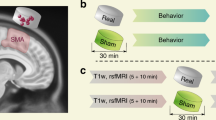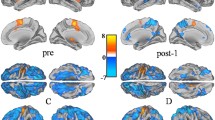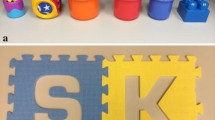Abstract
Studies employing functional magnetic resonance imaging (fMRI) have highlighted a covariation between the amplitude of hemodynamic responses recorded in primary and supplementary motor areas (M1 and SMA) and the duration of a motor task. A subset of these studies have hinted to a possible functional dissociation between processing carried out in these areas, with SMA primarily involved in action preparation, while M1 involved in action execution. This proposed functional dissociation was explored in the present study using a different technique—functional near-infrared spectroscopy—which enabled a finer-grained monitoring of the temporal characteristics of the hemodynamic response compared to fMRI. Here, hemodynamic responses in M1 and SMA were recorded in 7 participants during a right-finger-tapping task of short (1 s) or long (3 s) duration. Hemodynamic responses of larger amplitude were recorded from both contralateral M1 and SMA during long-duration than short-duration tapping. Furthermore, the analysis of the temporal profiles of these responses revealed a more sustained and prolonged activity for long-duration versus short-duration tapping in M1, but not in SMA. Rather than functionally dissociable areas, the present results are more compatible with the hypothesis that M1 and SMA subserve different, though strongly interacting, functional subroutines subtended in motor task preparation and execution.




Similar content being viewed by others
Notes
The left-handed participant was not excluded from analysis in order to prevent lack of power. When examined in isolation, the pattern of cortical activity exhibited by this left-handed participant was not dissimilar from that observed in right-handed participants.
References
Birn RM, Saad ZS, Bandettini PA (2001) Spatial heterogeneity of the nonlinear dynamics in the FMRI BOLD response. NeuroImage 14(4):817–826
Boas D, Franceschini M, Dunn A, Strangman G (2002) Noninvasive imaging of cerebral activation with diffuse optical tomography. In: Frostig R (ed) In vivo optical imaging of brain function. CRC Press, Boca Raton, pp 193–221
Cutini S, Scatturin P, Zorzi M (2011) A new method based on ICBM152 head surface for probe placement in multichannel fNIRS. NeuroImage 54(2):919–927
Cutini S, Basso Moro S, Bisconti S (2012) Functional near infrared optical imaging in cognitive neuroscience: an introductory review. J Near Infrared Spectrosc 20(1):75–92
Glover GH (1999) Deconvolution of impulse response in event-related BOLD fMRI. NeuroImage 9(4):416–429
Kasess CH, Windischberger C, Cunnington R, Lanzenberger R, Pezawas L, Moser E (2008) The suppressive influence of SMA on M1 in motor imagery revealed by fMRI and dynamic causal modeling. NeuroImage 40(2):828–837
Leff DR, Orihuela-Espina F, Elwell CE, Athanasiou T, Delpy DT, Darzi AW, Yang GZ (2011) Assessment of the cerebral cortex during motor task behaviours in adults: a systematic review of functional near infrared spectroscopy (fNIRS) studies. NeuroImage 54(4):2922–2936
Miller KL, Luh WM, Liu TT, Martinez A, Obata T, Wong EC, Frank LR et al (2001) Nonlinear temporal dynamics of the cerebral blood flow response. Hum Brain Mapp 13(1):1–12
Scarpa F, Cutini S, Scatturin P, Dell’Acqua R, Sparacino G (2010) Bayesian filtering of human brain hemodynamic activity elicited by visual short-term maintenance recorded through functional near-infrared spectroscopy (fNIRS). Opt Express 18(25):26550–26568
Scarpa F, Brigadoi S, Cutini S, Scatturin P, Zorzi M, Dell’Acqua R, Sparacino G (2011) A methodology to improve estimation of stimulus-evoked hemodynamic response from fNIRS measurements. Ann Int Conf IEEE Eng Med Biol Soc, 785–788
Sharp DJ, Bonnelle V, De Boissezon X, Beckmann CF, James SG, Patel MC, Mehta MA (2010) Distinct frontal systems for response inhibition, attentional capture, and error processing. Proc Natl Acad Sci (USA) 107(13):6106–6111
Conflict of interest
This supplement was not sponsored by outside commercial interests. It was funded entirely by ECONA, Via dei Marsi, 78, 00185 Roma, Italy.
Author information
Authors and Affiliations
Corresponding author
Rights and permissions
About this article
Cite this article
Brigadoi, S., Cutini, S., Scarpa, F. et al. Exploring the role of primary and supplementary motor areas in simple motor tasks with fNIRS. Cogn Process 13 (Suppl 1), 97–101 (2012). https://doi.org/10.1007/s10339-012-0446-z
Published:
Issue Date:
DOI: https://doi.org/10.1007/s10339-012-0446-z




